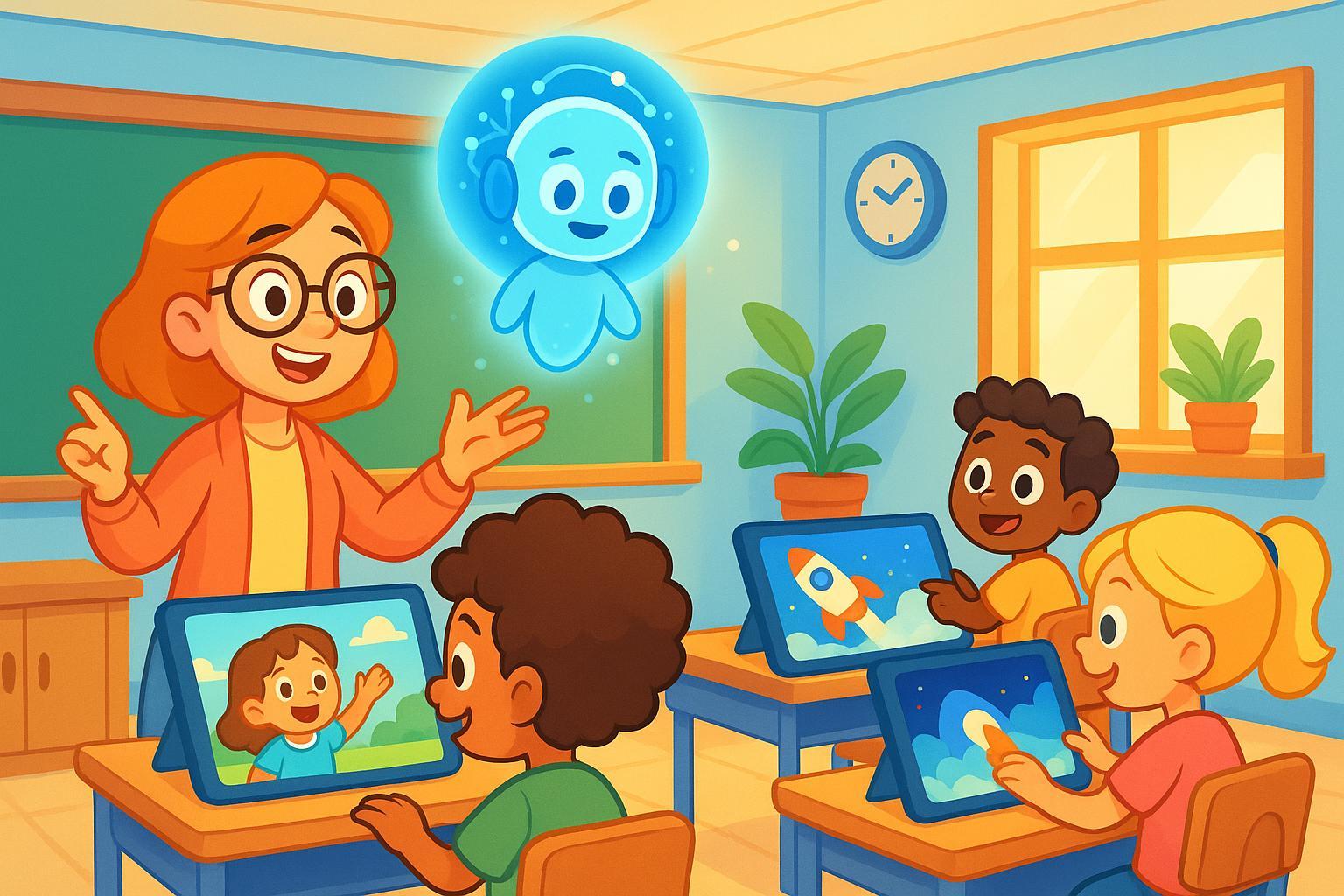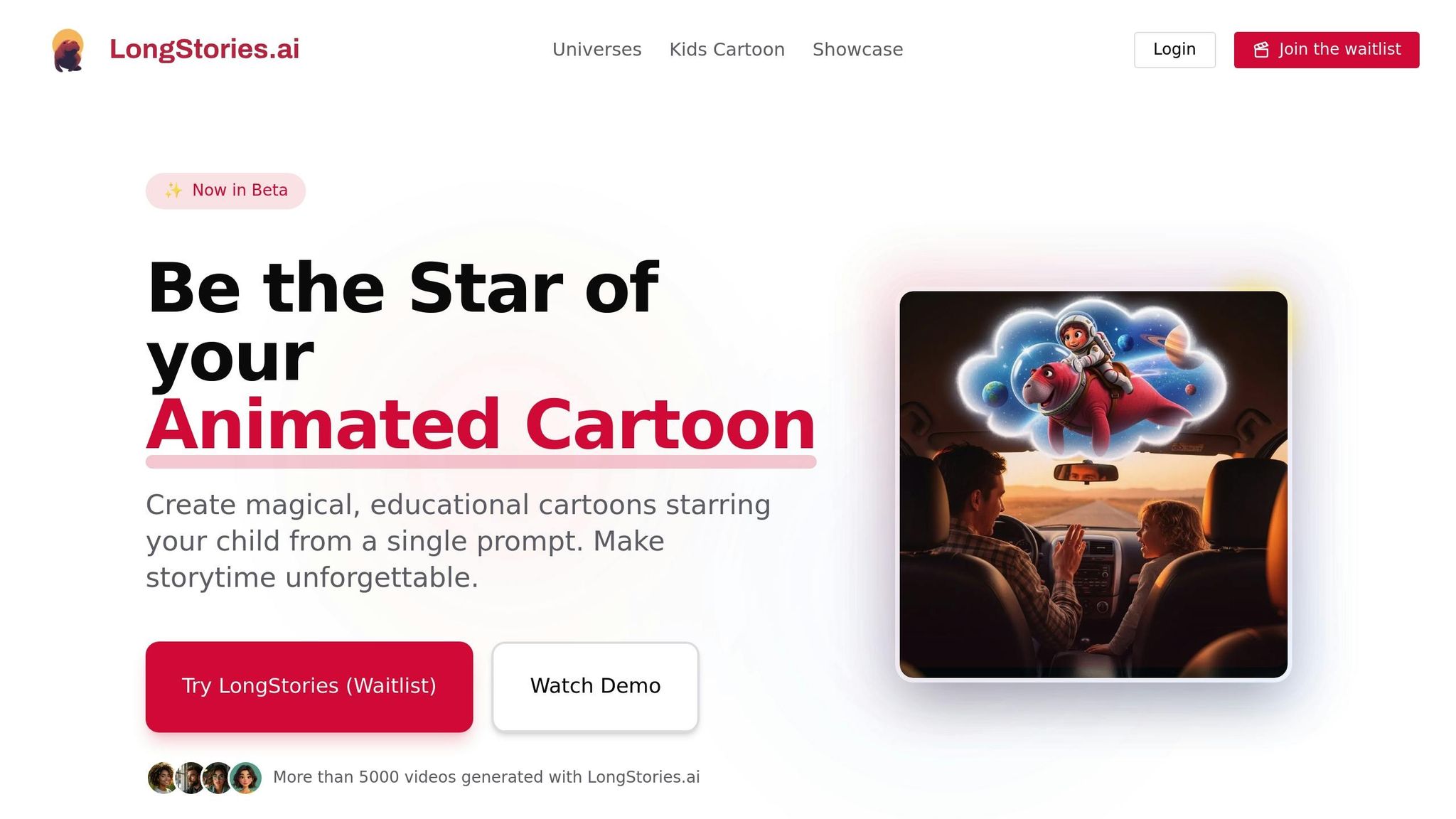
LongStories is constantly evolving as it finds its product-market fit. Features, pricing, and offerings are continuously being refined and updated. The information in this blog post reflects our understanding at the time of writing. Please always check LongStories.ai for the latest information about our products, features, and pricing, or contact us directly for the most current details.
How AI Personalizes Learning in Animated Videos
AI is transforming education by creating animated videos tailored to each child's learning style. Here's how:
- Better Learning Outcomes: Personalized AI tools improve test scores by up to 62% and boost retention rates with engaging visuals.
- Real-Time Adaptation: AI analyzes how kids interact with videos (pauses, replays) to adjust pacing, difficulty, and focus areas.
- Interactive Features: Quizzes and branching storylines adapt based on responses, making lessons more engaging and effective.
- Custom Stories: AI crafts adventures with relatable characters, child-specific traits, and even custom visuals, keeping kids motivated.
- Broader Accessibility: Tools like LongStories.ai make it easy to create personalized animations in minutes, catering to diverse learning needs.
AI-powered animated videos not only simplify complex concepts but also enhance skills like problem-solving and language development. However, ethical concerns like data privacy and bias in AI-generated content must be addressed to ensure fairness and quality. The future of education lies in blending AI’s efficiency with human expertise to create inclusive, engaging learning experiences.
AI-Powered Personalization: Transforming Education
How AI Personalizes Animated Educational Content
AI is changing the way animated educational videos work, turning them from generic lessons into tailored learning experiences. By analyzing how kids interact with the content, it adjusts pacing, character responses, and even the storyline to fit individual needs.
Learning Behavior Analysis
AI keeps track of how children interact with videos - like when they pause, replay, or engage with specific parts. These behaviors help build a profile of each child's learning style and highlight areas where they might struggle or excel. For instance, if a child frequently pauses during a math explanation or replays a science experiment, the system interprets this as either a challenge or heightened curiosity.
Using this data, AI-powered tools can create quizzes and exercises that focus on areas where the child needs more practice, while skipping over concepts they’ve already mastered. This approach creates a custom learning path for every student.
Interactive videos add another layer of personalization. Studies reveal that children who engage with fully interactive episodes score 63% on assessments, compared to 56% for those watching noninteractive versions. This 7% improvement underscores how active engagement, driven by AI, can make a big difference in learning outcomes.
With these insights, AI doesn't just observe; it actively adjusts the content to match the learner's needs in real time.
Dynamic Content Customization
Once AI maps out a child's learning habits, it adjusts the animated content accordingly. It can modify the pace, difficulty, and even the sequence of lessons. For quick learners, the system speeds up and introduces more advanced material. For those needing extra help, it slows down and provides additional examples to reinforce tricky concepts.
AI also recommends videos based on the child’s past preferences and learning patterns, directing them to the most relevant sections of content.
Interactive elements, like quizzes and branching scenarios, adapt as well. If a child answers a question incorrectly, the system might offer a simpler explanation or a new visual demonstration to clarify the concept. This ensures that the learning experience evolves based on how the child responds.
But AI doesn’t stop at pacing and quizzes - it takes personalization a step further by tailoring the stories themselves.
Child-Focused Storytelling
AI makes animated stories more engaging by weaving in elements that resonate with each child. Characters can be designed to reflect user-specific traits, creating a sense of connection.
Interactive storytelling plays a key role here. For example, in an episode about liquid viscosity, a character might ask, “Why do you think the ketchup isn’t coming out?” If the child responds, “It’s stuck,” the character could follow up with, “Yeah, I wonder why it’s stuck. Do you think it’s too thick or too thin?”. This conversational style turns passive watching into an active learning experience.
Researcher Ying Xu highlights this capability:
"AI characters can ask kids a question and then customize a response to each child's unique answer."
AI can also craft stories that align with a child’s interests and goals. By analyzing their preferences and personality, it creates animated adventures that hold their attention, even during longer sessions.
The personalization extends to visual and audio elements as well. AI can design custom avatars, unique backgrounds, and animations that reflect a child’s tastes. It can even provide voiceovers and dubbing in multiple languages, making the content accessible to kids from various linguistic backgrounds. This attention to detail ensures that every aspect of the story feels tailored, keeping learners engaged and motivated.
Educational Benefits of AI-Driven Animated Videos
AI-driven animated videos are reshaping how children learn, offering measurable benefits that go beyond traditional methods. By combining engaging visuals with personalized content, these tools enhance both comprehension and retention, making lessons more effective and enjoyable.
Better Retention and Attention
Animated videos have a proven edge when it comes to helping students retain information. Studies show that viewers remember 95% of a lesson delivered via video, compared to just 10% from text-based learning. When AI tailors these videos to fit a child's unique learning style, the impact becomes even stronger.
This is especially important because many people are naturally drawn to visual learning. About 65% of the population identifies as visual learners, and the brain is wired to process visuals much faster - 60,000 times faster than text, in fact. When these visuals are customized to suit individual preferences, they not only capture attention but also deepen understanding.
Teachers and students alike report positive outcomes. 66% of educators say animated videos boost student motivation, while 83% of students feel these videos make learning easier.
"The power of animation in education lies in its ability to present information in a way that aligns with how our brains naturally process information, reducing cognitive load while maximizing retention."
Additionally, animation helps students stay focused and improves how well they can recall and apply what they’ve learned. Research indicates that animated lessons can cut learning time by up to 60% while significantly increasing information retention.
Improved Complex Skills
AI-powered animated videos aren’t just about simplifying lessons - they also help students develop more advanced skills. These tools have shown remarkable success in enhancing spatial reasoning, problem-solving abilities, and language development. In fact, adaptive AI education can improve performance in complex skills by up to 30% and boost memory retention by as much as 65%. When storytelling is used, language skills can improve by 30%, as narratives are tailored to match each child’s vocabulary and interests.
One of the standout features of animation is its ability to make abstract ideas more concrete. As Michelle Connolly explains:
"Animation gives students a window into invisible processes. When a student can visualize electron movement or see geometric transformations unfold, their comprehension jumps dramatically."
AI also enhances learning through interactive features. By using tools like computer vision and natural language processing, these videos adapt in real time to a student’s progress. They adjust difficulty levels, answer questions, and provide tailored feedback, creating a dynamic learning experience that traditional methods simply can’t match. This adaptability not only makes complex ideas easier to grasp but also reinforces each student’s unique learning path.
sbb-itb-94859ad
Practical Applications of AI in Animated Learning
AI-powered animated videos are reshaping education by offering practical, engaging solutions for personalized learning. Platforms like LongStories.ai have made it possible for parents and educators to create custom educational content without needing technical expertise. These tools adapt lessons to fit specific subjects and individual learning needs, opening up new possibilities for interactive and tailored education.
LongStories.ai and Personalized Adventures

LongStories.ai is a standout example of how AI can transform learning into a personalized and immersive experience. This platform allows parents and teachers to turn a simple text prompt into a fully voiced, high-definition animated cartoon, where the child becomes the star of the story. Since its launch, LongStories.ai has generated over 5,000 personalized video adventures, making learning both fun and relatable.
The platform introduces unique AI characters like Manny the Manatee, Carter the Job Reporter, and Professor Time, each designed to guide children through various educational topics. With flexible pricing options, LongStories.ai ensures that these personalized animated adventures are accessible to a wide range of users.
Subject-Specific Adaptations
AI goes beyond storytelling by tailoring content to address specific educational challenges. For example, it uses performance data to pinpoint areas where a student might struggle and predicts outcomes to craft individualized learning paths.
- Mathematics: AI can simplify abstract concepts by generating visual representations, making them easier to grasp.
- Science: Animated demonstrations bring invisible processes to life, helping students understand complex ideas.
- Language Learning: Storytelling adapts to a child’s vocabulary and interests, providing a more engaging way to learn.
These AI-driven methods have gained significant support from students. Research highlights that 88% of students recognize the importance of AI in education, 74% see it as a valuable alternative to traditional self-learning methods, and 88% welcome the idea of AI acting as a virtual tutor or intelligent assistant.
Catering to Diverse Learning Styles
AI also addresses the variety of learning styles among students, creating materials tailored for visual, auditory, or kinesthetic learners. This individualized approach can combat the growing issue of student disengagement, as many lose interest by the time they reach 12th grade.
Moreover, AI tools are increasingly designed to support students with special needs. These tools can enhance writing skills, foster collaboration, and adapt content to provide the right level of challenge without overwhelming the learner.
As Cristian Randieri aptly puts it in Forbes:
"The future of education lies at the intersection of innovation and ethical management."
AI’s ability to personalize and adapt educational content is not just a technological advance - it’s a meaningful step toward addressing the diverse needs of today’s learners.
Challenges and Ethical Considerations
AI is reshaping personalized learning by delivering tailored educational content, but it comes with notable ethical hurdles. Among the most pressing concerns are safeguarding children's sensitive data and addressing fairness in AI-generated content.
Data Privacy and Security
AI-powered educational platforms gather extensive data about children, such as personal details, academic progress, and even behavioral tendencies. This level of data collection raises serious privacy concerns, especially since young learners may not fully understand how their information is being used.
Some systems go even further, capturing facial expressions and vocal tones to analyze emotional responses. While this data can enhance personalized learning, constant monitoring risks affecting students' well-being. To address these issues, schools and platforms must adopt strict data protection measures. This includes offering clear, transparent explanations about what data is collected, how it’s stored, and its intended use. Parents and educators need this transparency to make informed decisions. Additionally, platforms should build in privacy features that are age-appropriate, giving children the option to opt out of data collection when feasible.
The way data is handled also ties into concerns about fairness in the creation of educational content.
Bias in AI-Generated Content
AI systems, if trained on biased datasets, can unintentionally reinforce harmful stereotypes or discriminatory practices. This is particularly troubling in education, as biased content can influence how children see themselves and the world. Instances of unfairness have already surfaced in areas like automated grading and risk assessment tools, which have disproportionately affected students from underprivileged backgrounds.
To counteract these issues, developers must train AI models using diverse and representative datasets and continuously monitor for any discriminatory outcomes. As Ken Shelton and Dee Lanier aptly point out:
"The bias that exists 'out there' is the same bias that exists in ourselves."
Building inclusive development teams and conducting regular bias audits are essential steps to ensure AI-generated content reflects a broad range of perspectives. This effort can help create learning materials that positively represent all students, fostering a more equitable educational experience.
Maintaining Content Quality
Another challenge lies in ensuring the accuracy and consistency of AI-generated content. Unlike human-curated materials, AI content can sometimes include errors or fail to meet established standards. Education technology expert Shelby Moquin emphasizes:
"Ethical AI in education means designing, using, and managing AI tools in a way that puts people first - focusing on fairness, transparency, and the well-being of students and educators."
To uphold these principles, platforms should implement strong quality control processes, including human oversight of AI-generated materials. Regular monitoring for errors and clear guidelines on the responsible use of AI tools are critical. This approach ensures that AI complements, rather than replaces, human creativity and expertise. By combining AI’s efficiency with the insights of skilled educators, platforms can deliver personalized learning while maintaining high ethical and quality standards.
Finally, comprehensive policies are needed to ensure transparency, accessibility, and equity in AI-driven education. This includes making sure AI tools are effective for students with disabilities and do not exacerbate existing educational disparities between communities. By addressing these challenges, AI can truly enhance learning without compromising fairness or quality.
Conclusion: The Future of Personalized Learning in Animated Videos
AI is reshaping the way children learn through animated videos, with even greater advancements on the horizon. Studies show that personalized learning can boost test scores by about 30%, triple engagement, and improve both attendance and retention rates. The AI education market, already gaining momentum, is projected to hit $20 billion by 2025.
Looking ahead, technologies like AR, VR, and the Metaverse are set to push animated learning into new dimensions. These tools aim to create immersive, interactive experiences that go far beyond traditional screen-based methods, allowing children to actively engage in animated environments tailored to their individual learning styles.
Another exciting shift is the growing collaboration between AI and humans. Instead of replacing teachers and animators, AI will act as a supportive tool - taking over repetitive tasks so educators can focus on mentoring and fostering creativity. This partnership underscores AI’s role as a complement to human expertise, not a substitute.
Platforms like LongStories.ai offer a glimpse into this future. By transforming a simple text prompt into a fully animated adventure in under a minute, it makes high-quality, personalized educational content accessible to parents and teachers, even without technical skills.
As more educational institutions adopt these tools - 57% of higher education organizations are now prioritizing AI - it’s essential to maintain human oversight and ethical practices. The goal isn’t to automate education but to craft engaging, effective, and inclusive learning experiences that cater to every child’s needs.
The future of personalized learning in animated videos lies in creating dynamic educational experiences that adapt to and celebrate each child’s unique way of learning.
FAQs
How does AI make animated videos engaging and tailored to each child's learning style?
AI takes animated learning to the next level by tailoring videos to match a child's individual learning style - whether they excel through visuals, sound, or hands-on activities. Using advanced algorithms, it creates personalized stories, adjusts pacing, and fine-tunes visuals to suit each child's preferences.
This customized method not only keeps kids engaged but also makes it easier for them to understand challenging concepts. By presenting information in a way that feels natural and enjoyable, AI boosts retention and transforms learning into a fun, interactive experience. It’s all about making education more effective and meaningful for every child.
How is children's data privacy protected when using AI-powered educational tools?
Protecting children's data privacy is a critical concern when using AI-driven educational tools. To keep kids safe, these platforms adhere to strict regulations like the Children's Online Privacy Protection Act (COPPA). This law ensures that any personal information collected from children under 13 requires verified parental consent. Schools also play an essential role by thoroughly evaluating AI tools to make sure they meet federal and state privacy standards, including the Family Educational Rights and Privacy Act (FERPA).
Beyond compliance, schools and AI providers establish transparent privacy policies, conduct regular system assessments, and strictly limit data sharing to what is legally allowed. These efforts work together to build a secure and reliable digital learning space for children.
How do AI-generated animated videos promote fairness and inclusivity in education?
AI-generated animated videos help create a more inclusive and equitable learning environment by drawing on diverse datasets and carefully designed algorithms to reduce bias. These tools can tailor content to reflect a variety of backgrounds, ensuring students from all walks of life feel seen and included. Beyond representation, AI also personalizes lessons to meet individual needs, whether that's addressing language barriers or supporting students with disabilities.
By integrating systems that actively identify and address bias, AI contributes to fairer educational materials. This ensures that every student has access to engaging, relevant learning experiences, fostering better outcomes for all.
